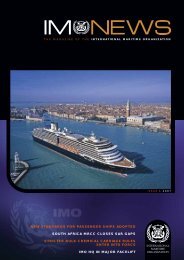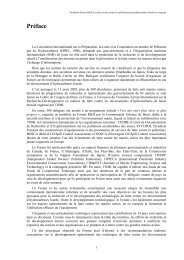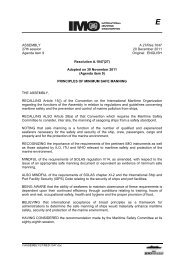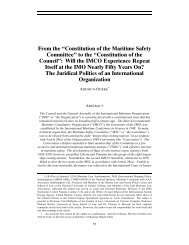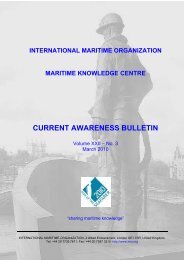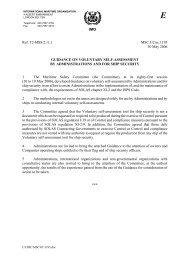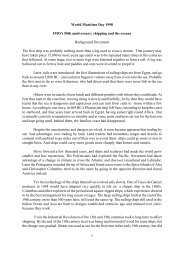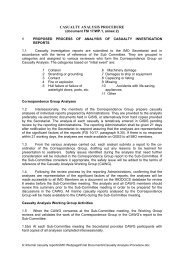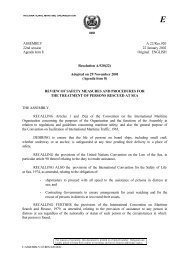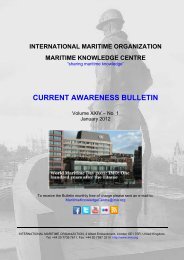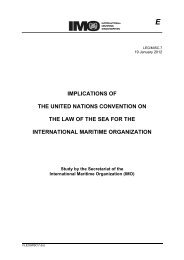Radioactive Waste Disposal at Sea: Public Ideas ... - IMO
Radioactive Waste Disposal at Sea: Public Ideas ... - IMO
Radioactive Waste Disposal at Sea: Public Ideas ... - IMO
Create successful ePaper yourself
Turn your PDF publications into a flip-book with our unique Google optimized e-Paper software.
134 Chapter 8<br />
At the same time it was alleged th<strong>at</strong> parts of the oceans had a considerable<br />
capacity to assimil<strong>at</strong>e some wastes (Walsh 1981). 9<br />
Around the same time, the U.S. Environmental Protection Agency began<br />
to look to the oceans as a possible disposal altern<strong>at</strong>ive for both low-level<br />
and high-level radioactive wastes. <strong>Public</strong> concern over disposal of radioactive<br />
waste made it extremely difficult, if not impossible, to find sufficient<br />
permanent disposal facilities on land (Shabecoff 1982). One EPA official<br />
explained in 1981 (Dyer 1981, p. 11): “With increasing public concern for<br />
waste management practices on land and the need to find permanent disposal<br />
sites, the United St<strong>at</strong>es is again looking towards the oceans as a possible<br />
altern<strong>at</strong>ive to land disposal for both low-level and high-level<br />
radioactive waste.” 10 In addition, when weighing the costs and benefits of<br />
regul<strong>at</strong>ion, as the Reagan administr<strong>at</strong>ion urged the EPA to do, ocean disposal<br />
of old nuclear submarines was clearly more <strong>at</strong>tractive than land disposal.<br />
11 There also seemed to be a growing consensus among marine<br />
scientists th<strong>at</strong> radwaste disposal would cause no significant risks to either<br />
human health or the marine environment. 12 Thus, in 1980 the EPA began<br />
revising existing regul<strong>at</strong>ions so th<strong>at</strong> thousands of tons of slightly contamin<strong>at</strong>ed<br />
soil left over from the Manh<strong>at</strong>tan Project and more than 100 retired<br />
nuclear submarines, each representing more than 50,000 curies of radioactive<br />
waste, could be dumped <strong>at</strong> sea. 13<br />
The possibility of a change in the EPA’s policy on disposal of radioactive<br />
m<strong>at</strong>erials in the ocean sparked considerable alarm within the environmental<br />
community. <strong>Public</strong> <strong>at</strong>tention was <strong>at</strong>tracted to radioactive waste dumped<br />
from the 1946 to 1970 when drums were found unexpectedly and previously<br />
unknown dump sites were disclosed. The EPA sent some of its<br />
researchers to examine a former site near Boston for health effects. 14 As the<br />
EPA scientists expected, however, no evidence of harm was turned up. 15 The<br />
public visibility of the issue was further heightened as environmental groups<br />
organized public policy forums and “citizen workshops” th<strong>at</strong> addressed<br />
past dumping in the United St<strong>at</strong>es, legal aspects of intern<strong>at</strong>ional regul<strong>at</strong>ion,<br />
and plans to bury high-level radioactive waste in the deep seabed. Hearings<br />
on the early dumping were held in San Francisco and in Boston, and a hearing<br />
on the proposed dumping of decommissioned submarines was held in<br />
North Carolina. 16 Environmental pressure groups, conserv<strong>at</strong>ionist groups,<br />
priv<strong>at</strong>e citizens, local business leaders, and commercial fishermen’s organiz<strong>at</strong>ions<br />
all advoc<strong>at</strong>ed a ban on disposal of radioactive waste in the ocean.



